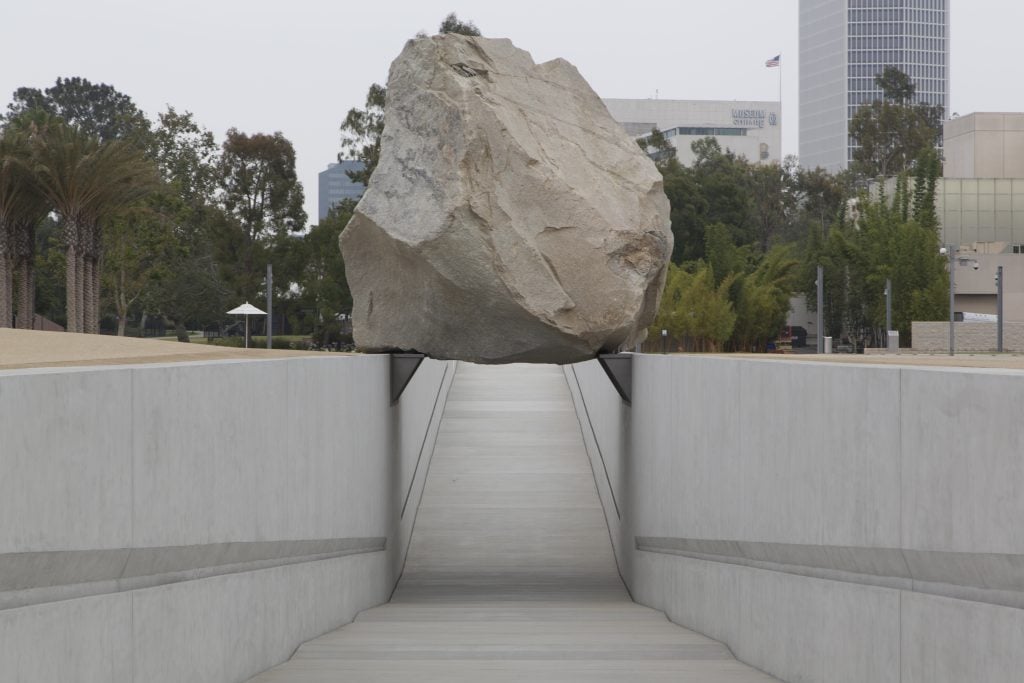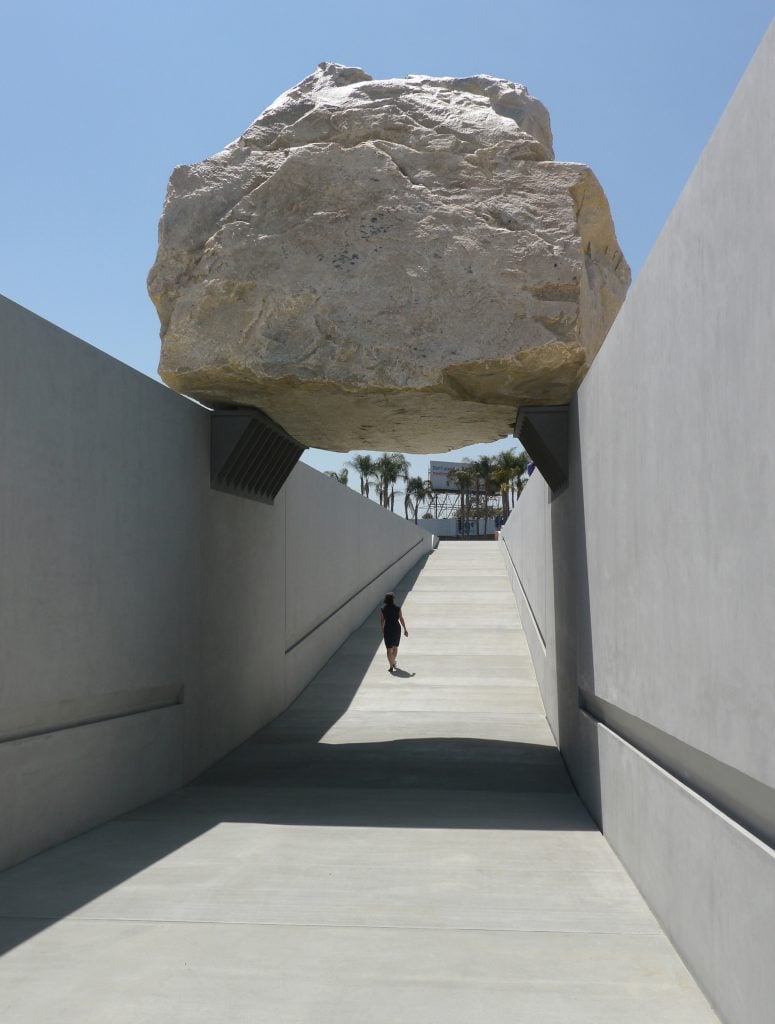Pop Culture
Art Behind the Meme: A Titanic Rock Sculpture
Online, the 340-ton granite boulder has been used to signify various threats, from the personal to the political.

Online, the 340-ton granite boulder has been used to signify various threats, from the personal to the political.

Brian Boucher

What’s in a meme? Sometimes, art. Art Behind the Meme brings you the low-down on the artworks that have achieved our era’s finest and rarest feat: virality. Read on for how these art-historical works have been reimagined for the age of social media.
Who could have guessed that one of Los Angeles’s most ambitious and priciest artworks could have been pressed into service to stand for sexually explicit chats with A.I.-fueled bots? Well, that is the world in which we find ourselves.
The artwork in question is Michael Heizer’s titanic sculpture Levitated Mass, which was unveiled at the Los Angeles County Museum of Art in 2012 after an epic 11-day journey from a quarry some 60 miles away. The piece consists of a granite boulder weighing some 340 tons and standing 21 feet high, perched on two small shelves so that it stands above a 456-foot-long, 15-foot-wide trench that gradually arrives under the boulder at 15 feet below ground level. It opened June 24, 2012 to massive crowds. It is one of the rare artworks to have an eponymous feature-length documentary devoted to it.

Michael Heizer, Levitated Mass (2012). Los Angeles County Museum of Art © Michael Heizer. Courtesy of the artist and Gagosian. Photo: LACMA.
The piece didn’t just make a long journey across four California counties in 2012, though; it had already completed a journey in time some 43 years long. Heizer conceived the piece in 1969 and first tried to execute it that year. He had secured a 120-ton rock that he obtained in the Sierra Mountains above Reno, Nevada and he had excavated a trench in a lakebed in Nevada, but the rock proved too heavy to work with, breaking some of the equipment that was brought to bear to move it.
In 2007, Heizer was working at the Pyrite-Hubbs Quarry in 2007 when a detonation knocked loose a 340-ton boulder. Heizer deemed it perfect, and worked it out with Michael Govan, LACMA’s director, to bring the rock along what ended up being a 105-mile route, with movement happening only from 10 p.m. to 6 a.m. More than 1,000 people were there to greet it when it arrived at the museum in the middle of the night in spring 2012.
There, the artwork has become a popular attraction along with its counterpart, Chris Burden’s sculpture Urban Light (2008), with its dozens of antique streetlights. Govan has described the two as standing for the ancient earth under Angelenos’ feet and the metropolis that has developed on it.
Heizer is one of the progenitors of the form known as Land Art, in which the earth itself becomes the artist’s medium, along with fellow-Americans like Walter De Maria, Nancy Holt, Ana Mendieta, Robert Smithson, and James Turrell, as well as Brits Andy Goldsworthy and Richard Long. One of his earliest and most iconic works is Double Negative (1969), for which he excavated 240,000 tons of rock to create two 50-foot-deep cuts in facing cliff edges of Mormon Mesa, in Nevada. In 1970, he began work on the far more massive City in the Nevada Desert, a project drawing inspiration from Native American mound-building traditions and Colombian ritual cities, keeping it off-limits for decades before finally revealing it in 2022.
“As long as you’re going to make a sculpture,” Heizer has said, “why not make one that competes with a 747, or the Empire State Building, or the Golden Gate Bridge?”
Writing in the Los Angeles Times, though, critic Christopher Knight wasn’t convinced that this one lives up to that standard. “Levitated Mass isn’t exactly Stonehenge or Half Dome,” he wrote, going on to compare it unfavorably to a local boulder whose shadow is shaped like a bird of prey. “It’s not even Eagle Rock. As monoliths go, the stone seems rather modest.”
All the same, the piece has proven as enduringly popular as you would imagine. Scroll through the #levitatedmass hashtag on any social media platform and you’ll find dozens of photos of it, including many gag shots where people pose as if holding the megalith aloft, Tower of Pisa–style.
It has also come in handy for meme makers, with its crushing 680,000-pound weight roped into service to stand for seriously undesirable things. Even Replika, the “A.I. companion who cares,” which offered bots that engaged in sexually explicit roleplay with paid users, employed the megalith in advertisements to stand for the curse of single-hood.

Replika AI’s advertisements, courtesy Vice.
Along the same lines, ConfusePrince posted a shot to imgur of a tiny dog under the rock, which stands for illness, with only recreation and online humor saving the day.
Ska band K-Man and the 45s say that punk and ska music are the only things saving them from poor mental health, though they would be open to adding another genre to the mix.
Add a dash of Reggae and everything’s gonna be alright. #anxiety #Depresion #punk #Ska #Reggae #Cure #thecure #hanginthere #turnitup #music #musicsaves pic.twitter.com/F2AGMyxRba
— K-MAN & THE 45s (Official) (@Kman45s) February 2, 2022
The Anarchist Meme Collective, meanwhile, used Levitated Mass as a metaphor for something a bit more serious than not having a bot to exchange NSFW pics with.
— Anarchist Meme Collective (@AnarchistMemeCo) June 20, 2021
Others have drawn art historical parallels. Portfolio Camel, on X (formerly Twitter) compared Heizer’s work with an image of Sisyphus, condemned to always push a rock up a mountain, only to see it roll down again.
An obstacle was often there
To silence me when I began to speak.— Cavafy — | Hidden Things
Levitated Mass . Michael Heizer . LACMA
Sisyphus . Friedrich John pic.twitter.com/gpTAUJ5jLw— Portfolio Carmel (@PortfolioCarmel) September 15, 2019
Sasha Perl-Raver, also on X, asked whether a certain movie star had posed with the similarly nicknamed artwork.
Has @TheRock taken a photo with The Rock at @LACMA, aka Levitated Mass? Because my OCD and my wildest dreams need that to happen.
— Sasha Perl-Raver (@sashaperlraver) September 11, 2016
TikToker Breadbestie says the Rock compares favorably with the Pacific Coast Highway for Californians with questions about the meaning of life.
@breadbestiewalking under the levitated mass just to feel something♬ Mariners Apartment Complex – Lana Del Rey
Want to make your own? There’s a Levitated Mass meme generator page, should you need something to levitate your mood.